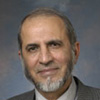 David Arnow
Jewish
David Arnow
Jewish
As Mary notes, Judaism and Christianity share traditions that identify Jerusalem as the “navel of the earth.” Jewish and Islamic sources further claim that creation itself began with a particular stone, the “foundation stone,” located in the city. According to Jewish legend, this stone would remain the locus of critical events. It would be the site of the altar on which Abraham bound his son Isaac as a sacrifice, the rock on which he rested his head for the night when he dreamt of angels ascending and descending a ladder reaching to the heavens, and the Holy of Holies in the Temple. The Dome of the Rock stands above that place today.
Given its mythic pride of place in the order of creation, it’s not surprising that myth wraps Jerusalem in visions of perfection. “No man ever met with an accident in Jerusalem; No fire ever broke out in Jerusalem; No structures ever collapsed in Jerusalem.”
The reality of course, could not have been more different. Warring empires repeatedly sacked and burnt Jerusalem, and slaughtered its residents in droves. Unsustainable tension between the realities and visions of perfection probably gave rise to legends about the existence of two Jerusalems, one the earthly city, the other in heaven. The origins of this myth reach back to a midrashic reading of a verse from Psalm 122, a psalm devoted to the pilgrims’ visit to the holy city. Psalms 122:3 speaks of “Jerusalem built up, a city knit together.” The phrase “knit together,” (shechubra la yachdav) which likely referred to the city’s fortifications* or its surrounding wall, supplied midrashically inclined readers with the basis for a vision of two distinct cities. According to the Talmud, God will remain in exile from the heavenly Jerusalem until the earthly city is rebuilt.*
Myth has likewise given rise to the popular meaning ascribed to the city’s name—“ir shalom,” “city of peace.” (Modern scholarship suggests the more likely origin is ur Shulmanu, the city of Shulmanu, city of the West Semitic god of that name.)* A fifth-century midrash tells a story about Jerusalem’s name that remains poignant today given the conflicts surrounding the city. This legend recounts that Abraham referred to the city as “yireh” (as in Genesis 22:14, “Adonai yireh,” “God has vision”). But Shem (strictly according to midrash) called it Shalem (as in Genesis 14:18, “King Melchizedek of Salem,” “Salem,” “Shalem” in Hebrew, meaning “peace”). God said, if I call the city yireh, one righteous man will be offended. If I call it Salem, the other righteous man will be offended. Therefore I will use both names, “Yirehshalem,” “He will see peace.”*
 Mary C. Boys
Christian
Mary C. Boys
Christian
As did Judaism, Christianity viewed Jerusalem as the axis mundi, the navel of the earth. Because of its rivalry with Judaism, however, early Christianity added a new layer to this symbolism. Texts in Ezekiel (5:5 and 38:12) seem to have first given rise to this symbolism, which was embellished in later writings, such the passage in the pseudepigraphal book, Jubilees 8:19: “Mount Zion was in the midst of the navel of the earth.”* Jerusalem as the center of the earth also occurs in rabbinic literature.* Christian teachers added a new dimension, connecting it to Christ. For example, Cyril, bishop of Jerusalem 349-384, preached about how Christ stretched out his hands on the cross to embrace “the ends of the world, for this Golgotha [the hill on which Jesus was crucified] is the very center of the earth.” Sophronius, patriarch of Jerusalem when Muslims conquered that city in the seventh century, wrote in one of his poems:
Let me walk your pavements
And go inside the Anastasis*
Where the King of all rose again
Trampling down the power of death
And as I venerate that worthy Tomb,
… .Prostrate I will kiss the navel point of the earth, that divine Rock
In which was fixed the wood
Which undid the curse of the tree
How great your glory, noble Rock, in which was fixed
The Cross, the Redemption of mankind.*
But more than rivalry with Judaism was at play in Christian attachment to the land. It was a living link to Jesus and his earliest followers: “If there were no places that could be seen and touched, the claim that God had entered human history could become a chimera.”*
 Muhammad Shafiq
Muslim
Muhammad Shafiq
Muslim
Muhammad’s night journey and ascension into heaven (al-lsra’ and al Mi’raj) are significant in Muslim tradition. According to Muslim tradition, Muhammad was transported one night on a winged mule (Burraq) from Mecca (Makkah) to Jerusalem. The archangel Gabriel was riding the mule. According to some narrations, he was welcomed at Jerusalem by all the prophets, including Abraham, Moses and Jesus (peace be upon all of them). After meeting them, Gabriel asked Muhammad to lead the prophets in prayers. Afterwards, Muhammad was brought to the place where the Dome of the Rock is built and ascended to heaven accompanied by Gabriel.
It is said that the top portion of the Rock ascended with Muhammad until he reached heaven and then it returned to its place. Today it sits on the top of the rock like a canopy. There is a mark on the top of the Rock that is said to be Muhammad’s footprint. There is also is a mark of Abraham’s feet on a stone on which, according to Muslim tradition, he stood to build the Ka`ba — the House of God at Makkah. In his ascension, Muhammad passed through the seven heavens where he encountered earlier prophets.
During his ascension to heaven, Muhammad received the command to establish five daily prayers (Salat) that all Muslims must perform. It is said that God first commanded him to worship 50 times a day. When Moses heard about it, he persuaded Muhammad to go back to God to reduce the number. Because of Muhammad’s plea, God reduced it to 10 times. Moses insisted that also was too many and said he must go back to God to further reduce the number. Again at Muhammad’s request, God reduced it to five times a day. He said whoever would pray five times daily would be rewarded as though the person had prayed 50 times. Moses told Muhammad that even five times were too many because his people found it hard to pray just three times a day. Muhammad responded that he hoped the community would fulfill its obligation of five times.
The story of Isra and Miraj is full of wonderful signs and symbols. Muslim scholars, Sufis (mystics) and poets have interpreted it in deep, meaningful ways. There is, however, one essential point: It is an example of every Muslim’s deep devotion and spiritual connection with Jerusalem.
The whole journey happened in a portion of a night, although some critics argue Muhammad’s journey was spiritual and not physical. Like Christians and Muslims who believe that Jesus physically ascended to heaven, most Muslims believe in Muhammad’s physical ascension to the heavens on that night.